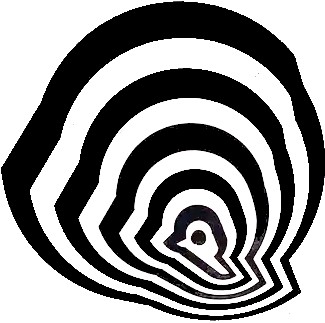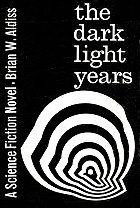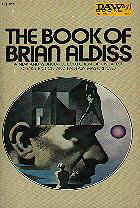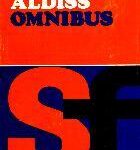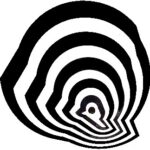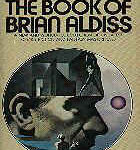The Inhumanity of Brian W. Aldiss
or, Why Do the Aliens Get All the Best Lines?
by Donna Ross Hooley
Brian W. Aldiss’s aliens demand a response. They’re eerie, as are the shaggy, horned phagors with their harneys instead of brains in the Helliconia trilogy ; they’re repulsive, as are the 800-pound utods in the novel The Dark Light-Years, ” ‘overgrown pigs that wallow in their own filth in a way no self-respecting Earth pig would do. . .’ ” (56) ; they’re ridiculous, as in this description of a “flamboyant,” “towering” redul, the gladiator trainer Ik so Baar from the short story “In the Arena”: “The white tiara that fitted around his antennae appeared only on sports day” (93). The issue isn’t whether or not the alien Others and machine Others are human; it is whether or not they merit human rights. Of course they aren’t human; only humans can be human, and even the human Others are usually treated no better than slaves. An animal can be brutal, a machine pitiless, an alien true to his own nature or perverting it according to his own kind, but only a man can be inhuman.
The human Others are often a consequence of the passage of millions of years, as in the short story collection Starswarm, which covers a million centuries: “Over the millennia since interstellar flight. . .genetic stability disappeared. . . each center of civilization bred new ways of thought, of feeling, of shape–of–life itself” (12). The ones who are designated as human are permeated by change in societies where their inferior brothers, lower branches on the family tree, are subservient to the newer evolutionary–or genetically manipulated–line. In “A Kind of Artistry,” the bizarre man and woman convention designates as human are in sharp contrast to their servant Others. The woman /man are also mother/son and lovers; they are incredibly longlived, incestuously obsessed, and psychically adept. The Lady provokes her lover/son Derek into striking her (it feels so good ’til he stops) and then into diving into the ocean, where he turns into a seal and swims away (don’t look at me; I don’t write ’em; I just explain ’em). In contrast, while those two play their roles, the first-person narrator provides the commentary and sets the tone. He is a Hols, a subservient Other of human ancestry, who gets to express that “We parthenos will never understand the luxuries of a divided mind. Surely suffering as much as happiness is a kind of artistry?” (26)
In “The Underprivileged,” the human Others are Saton and Corbis, reptilian descendants of the human race. They find themselves relocated, and Saton turns to Corbis: “The beautiful yellow pupils of her eyes had contracted to slits in fear. As he looked at her, loving her, the fear suddenly enveloped him too. He was overcome by the distrust the Istinogurzibeshilahans had for the races of humanity they called Warms. It was the distrust the underprivileged feel for those who have the advantages, and because it was instinctive, it went deep” (41). Corbis says, ” ‘I feel that we are despised as an inferior species of man’ ” (47-48). The fear is not unfounded; the story ends in horror when Saton and Corbis realize they have been given an injection unawares that makes them always happy. Their human guide, asked if he has the injection too, says, ” ‘Certainly. Only being resident, I don’t need as much as. . .as visitors. Only the very eminent are allowed to be creatively miserable’ ” (52).
In “All the World’s Tears” the human Other is Ployploy; her dad’s shrink says this of her: ” ‘How far back can you recede? She’s gentle. . . She wants to love. . .Oh, it’s obscene. . .She couldn’t hate to save her life. She’s no better than a savage. She’s worse than a savage, she’s mad!’ ” (106) A wild man finds her and touches her out of love and desire; she explodes, having been booby-trapped by the Mating Center so she won’t breed more recessives here in the enlightened Forty-Fourth century. It is the human Other Ployploy who cries the last tear in the world; her father’s psychodynamician watches the event unfold: “And although he was shallow and hard by the standards of other ages, he was human enough to sense that here–here on the graying terrace–was a little charade that marked the end of all that man had been” (103).
These sophisticated humans do not understand what sixteen-year-old Pete understands in “The Soft Predicament”: ” ‘Life without plumbing, life with a half full belly. . . It has a savor to it. . . It doesn’t make you less a human being. There’s no particular virtue in being white of skin and crapping into a nice china bowl every time the laxatives take hold’ ” (152). Aldiss’s human Others often point up that either they themselves or those who are designated human seem to be deficient in humanity in some fundamental way, lacking individuality, or empathy or creativity, perhaps initiative, or adaptability or unpredictability or lust for power or even the forgetfulness that is both the great blessing and the great curse of mankind. Each of these Aldiss in one tale or another earmarks as a characteristic of humanity. As Art says in “Secret of a Mighty City,” ” ‘All men and women have hearts, even the cruel ones. . . The good in them gradually gets overlaid and lost. You start good, you end bad just because you–oh, hell, you forget, I suppose. You forget you’re human’ ” (130). Art, a film maker, “made it quite clear that the thronging multitude. . were. . . harmless. Living in flocks, they had developed the flock mentality. . . .all they asked was a nice time” (133).
Speaking of Art, characters’ names also resonate with either normality or Otherness. A kinship is felt with Hols and Jon, with mousy little Alice in “Three’s a Cloud,” with David, “Supertoys’” android child . Names create Otherness, with various effects: partly comic, partly anti-sentimental, sometimes symbolic (note the initials of Master Explorer Bruce Ainson of The Dark Light-Years). For every Mary in a soldier’s dream in “Hearts and Engines,” there is an alien Other such as Thrash Pondo-Pons in “Legends of Smith’s Burst,” who hails from a planet where no two are born exactly alike, and he has the four arms and green fringe to prove it. For every Otto in “Amen and Out,” there is a Dandi Lashadusa in “Old Hundredth,” an Impure created by man, a sloth as big as an elephant who is a savant in musicolumnology. And of course the wonderful January Birdlip and Freddie Freud, the humans, and their personal machine Others called romen–robot men–the equally wonderful Bucket and Hippo, in “Comic Inferno.” The story revolves around the roman writer Toolust (As Hippo says, ” ‘Toolust is his pen name. It sounds less roman than his real name, which is Toolrust’ ” (37-38). And how very human the reasoning sounds behind the change. In “Gene Hive,” Gerund is the master, but Jeffy is his bonded servant, an inferior human Other in his own day but very much like a privileged man of today. Otherness, then, is inherent in names so not-of-our-tribe that they stand as a barrier between those with names such as Ployploy and connecting with, even perceiving, her as she is.
The machine Others, including Toolust and his cohorts in “Comic Inferno” and David in the “Supertoys” stories, struggle with the question of an existence separate from that of their creators, of deserving a designation other than as a tool of their creator. Is Toolust a machine or does he have “the quality humans called humanity” (The Dark Light-Years 115) ? Toolrust tells Birdlip, a black man, that the romen pursue ” ‘a policy that aims at freeing us from slavery. We want to be the equals of you men, not your whipping boys’ ” (42). When Birdlip protests that his race was once the world’s whipping boy, saying ” ‘But you are different–we made you!’ “(42), Toolust gets the last word: ” ‘The underdog is always different! He’s black or dirty or metal or something!’ ” (42)
David in “Supertoys” is the one in the story with the interesting problem–not the bored, grieving housewife or her husband with his bottom-line value system, but the android they think of alternately as a toy or a boy, a machine Other who can’t cope with rejection or his own lack of individuality. The robots of “Who Can Replace a Man?” experience yearning but not empathy. As their fellows fall victim to potholes or are jostled from their perches on their more mobile kin, the robots who forge ahead exhibit what would be a psychotic indifference in a man. However, they go on in hopes of assuming dominance, even considering war with what men might remain. It is the robot quarrier who says that ” ‘Men are more dangerous than machines. . .’ “(39), a comment that demonstrates a level of perception that goes beyond that of a machine.
Who can define a man? Any definition is informed by biases and questionable perceptions; as Clement Winter says in Forgotten Life, ” ‘Significance doesn’t lie in the object itself, but in the object as perceived, however erroneously or distortedly’ ” (223). However, the fact that a being exists that would prompt speculation already gives it a dignity and a mystery that can’t be quantified. It is also true, as Clement says of his brother, that self-perception can create significance: ” ‘There’s a mythological component to the mind. Being involved in the heroic campaigns in Burma restored Joe to a sense of his own significance. . .’ ” (278). When Toolust and the romen philosophize about their existence and build a weapon to defend themselves, when David wonders if he’s human and plucks a rose to put on his pillow for comfort because it reminds him of his mother, they demonstrate a level of awareness and individuality that is decidedly not machine-like. Toolust’s weapon strips man of the desire that has been awakened in the robot man; Toolust says, ” ‘A man faced with this pattern is at once comforted. . . He wants nothing above the basic needs of life: eating, sleeping. . .he becomes a complaisant animal. The weapon, you see is very humane’ ” (45). A similar fate is suffered, of course, by the human Others Saton and Corbis in “The Underprivileged.”
When Birdlip asks the roman Hippo to take him to Toolust, Birdlip has “a sudden memory, quickly suppressed, of the adventure stories of his boyhood, with the hero saying to the skull-sucking Martians, ‘Take me to your leader’” (37). Aldiss has his fair share of skull-sucking Martians– the Aurigans of The Saliva Tree, who harvest humans and their animals alike for food; the infiltrating invader alien Others of “Outside,” who mimic human form; the Blob, making a special appearance in “Gene Hive” ; the alien slave masters in “The Game of God”; and of course, Queen Victoria in “Send Her Victorious.” In these stories, the alien Others prompt the best lines. For instance, the narrator in “Gene Hive” is repulsed: “This heavy pseudo-man made me more frightened than I knew I could be”(118). When the thing reports that “We can never be anything but happy. . .”(120), the narrator tells it that ” ‘Curious creatures that we are, our best moments come when we are striving for something. . . There is a divine discontent, but divine content comes only to the beasts of the pasture’ ” (120). In “Outside” when the alien that mimics humans dissolves into its skeletal self under stress, it is the human authority, not the alien Other, who gets the last word this time: ” ‘The inhumanity inside will always give you away. . .However human you are outside’ ” (17).
That is so true for Queen Victoria in “Send Her Victorious,” a story with that puckish, dry Aldiss flair that is very nearly as singular as the wit of Aristophanes. So here’s the thing: Wherein Queen Victoria is the code name for the ultrasuperior alien(s) who created the earth and all that’s in it as the kind of experiment in population explosion humans do with rats. Her grave (gasp) is an empty portal to that alien dimension, and she’s out to get the humans who know the experiment has nearly run its course. The story reaches a crisis, and our hero (code name Florence Nightingale) realizes that “The dreaded Queen Victoria had struck and might be about to strike again”(168). He enters the other dimension, a rat in the lab but not in the cage, the scientist and her subject poised for the punch line: “She grabbed him up between two immense pudgy fingers. She was imperious, regal, she was Queen Victoria. And she was not amused” (190).
While the monster-movie Others tend to showcase what’s inherently human about the people who interact with them, the insightful alien Others reveal man’s inhumanity in all its arrogance and xenophobia. Many of these Others suffer at the hands of mankind, so much so that in “Old Hundredth” the mentor, an enhanced dolphin who is blind, placebound, and weary from 1,000 years of life, “was a killer more savage than the bear, keen to kill anything that might covet the vacant throne once held by men. The mere thought of men could send this mentor into sharklike fury at times” (157). Mankind’s reaction to alien Others is much the same as his reaction to the human Others in “Amen and Out,” the immortals, who are hated by nearly everyone, except for Otto. He’s the one who thinks, “The immies were too different, strange to look at, strange to talk to. . .” (123). He is also the one who rescues an immortal, ensconcing him at a perpetual pool party where the immy found himself “laughing as he had not done for many decades” (130).
And certainly one of the best examples of the depths men can sink to plays out in the1960s-era novella The Dark Light-Years. The utods appear first in the story; they are wise, perceptive, and happy. They have a racial memory of hundreds of millions of years; the Revolution Age lasted only 500 years, about half a utod lifetime. Their history reveals that they have already had their nuclear age, their warring factions, and have returned to a natural lifestyle. Even their spaceships are organic pods.
Their tranquility will not survive their encounters with humanity. The utods weigh around 900 pounds apiece; they are nasty, sluglike, with retractable limbs and eight orifices. They also enjoy wallowing in their own excrement. Humans are repulsed; they assume the utods are livestock and look around for their owners. On the other hand, a mother utod remarks to her son that “It is difficult to exchange ideas with Earthlegs because their vocabularies are so limited and their voice range so minimal. . .” (6). The utods also consider whether humans actually have space travel, observing that “the metal thing wasn’t the right shape for a spaceship” (71). The humans think the utods are too stupid to communicate; the utods, however, have conferred, and one of their leaders says, ” ‘I am no more prepared to converse with strangers bereft of my wallow than they would probably be prepared to converse with strangers bereft of the body materials that cover them’ ” (73). Humans kill six of the eight utods they first encounter, capturing the other two for study. When the utod race just doesn’t fight back, humans “generally agreed that the aliens were a degenerate form of life. . .” (115), slaughtering them to the point of extinction. The book ends on a chilling note; one of the surviving utods overhears a comment indicating that his race is nearly extinct just as the last humans are leaving the planet: “The younger one moved into the deserted building. He examined the armory. The soldiers had left it untouched, as directed by the one who had spoken about the deaths of so many utods. . . .He had remained patiently captive for a small fraction of his life. Now it was time he thought about freedom. Time, too, that the rest of his brothers thought about freedom” (128).
The young utod’s mother tells him, ” ‘Frequently there are several versions of the truth’ ” (8). Aldiss examines the truths about humanity’s Us and Them attitude, about our focus on the package instead of its contents, about our tendency to condemn outsiders. His Others offer an objective commentary–because they aren’t trees, they can see the forest; they serve as foils, by contrast illuminating the human characters; they present sentience and humanness as distinct; and they provide an opportunity to explore the human condition with a discrimination that is the essence of interpretive fiction. Many stories of Aldiss’s human Others underscore the ugliness of subjugation; his machine Others appear in stories written over a span of more than forty years that examine issues of artificial intelligence we just now stand on the brink of having to answer; and his alien Others are aliens, not just humans in costume. So what makes a man a man? Chun Hwa’s thoughts in “Blighted Profile” speak to what’s best in us: ” ‘I have lived ninety years. . . Yet something remains to be done. An essence of me still remains inside: my innermost heart: and that is as it was when I was a child. . . .I am yet myself; a continuity has been preserved’ ” (43). Brian Griffin and David Wingrove in Apertures: A Study of the Writings of Brian W. Aldiss say that “in The Malacia Tapestry Aldiss shows us. . .that Man is the sum of both thinking and feeling, of head and heart” (211). And the doctor in “O Ishrail!” offers a caution we might all do well to heed: ” ‘The patient has a fertile imagination; it has finally collapsed under the stress of too much reading–omnivorous reading, I may add, which has encompassed both learned works and cheap trash’ ” (73).
Works Cited
Aldiss, Brian W. The Book of Brian Aldiss. New York: DAW, 1972. (“All the World’s Tears,” “Amen and Out,” “Comic Inferno,” “In the Arena,” “Send Her Victorious,” “The Soft Predicament”).
—. The Canopy of Time. Great Britain: NEL, 1971. ( “Blighted Profile,” “Gene Hive,” “O Ishrail!”, “Secret of a Mighty City,” “Three’s a Cloud,” “Who Can Replace a Man?”).
—. The Dark Light-Years. New York: Signet, 1964.
—. Forgotten Life. New York: Atheneum, 1989.
—. Man in His Time. New York: Collier, 1990. (“Outside,” “The Saliva Tree”).
—. Starswarm. New York: Signet, 1964. (“A Kind of Artistry,” “The Game of God,” “Hearts and Engines,” “Legend of Smith’s Burst,” “Old Hundredth,” “The Underprivileged”).
—. Supertoys Last All Summer Long and Other Stories of Future Time. New York: St. Martin’s Griffen, 2001. (Title story).
Griffin, Brian, and David Wingrove. Apertures: A Study of the Writings of Brian W. Aldiss. London: Greenwood, 1984.
Copyright © 2003 Donna Ross Hooley
ABOUT THE CRITIC: Donna Ross Hooley is an Assistant Professor of English at Ogeechee Technical College in Statesboro, Ga. She taught high school in Darien, Ga, before receiving her M.A. from Georgia Southern College in 1982. She taught at Georgia Southern University from 1982- 2000, and was GSU’s Wells-Warren Professor of the Year 2000. She is the author of two textbooks and has published several poems, and is a Big Fan of Brian Aldiss.

